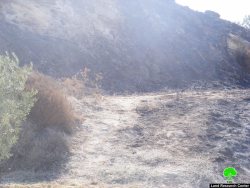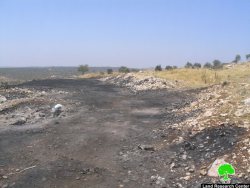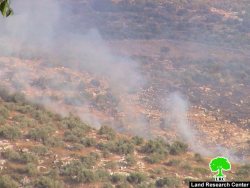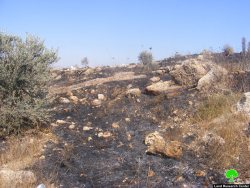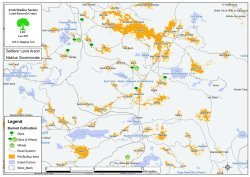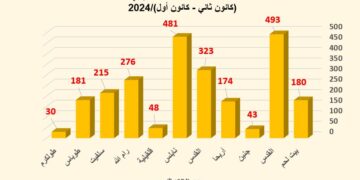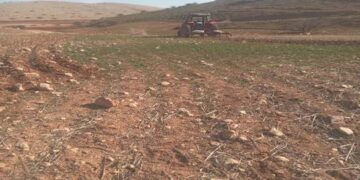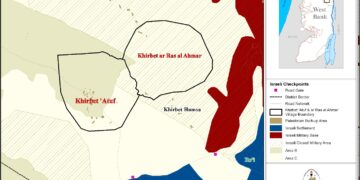The governorates of Nablus and Qalqiliya witnessed a new wave of arson attacks during last month against Palestinian agricultural land in which hundreds of dunums of cultivated land were burned.
Photo 1: Palestinian land on fire
The first attack:
It took place on the first of June at 8 AM when groups of settlers from Yizhar colony simultaneously began setting fire to the lands of six villages and towns in the south and east of Nablus city. The target land is located along the colonial road number 60 passing by the villages of Burin, Hawwara, Sura, Tel, Jit and Imatin causing the destruction of at least 1344 dunums. As a result more than 4000 fruitful olive trees were burned apart form the ground crops such as wheat, barley and vegetables. According to LRC field researcher the settlers set fire to 50 separate locations along the12 km long road starting from the colony of Kedumim in Qalqilya governorate to the colony of Yizhar near road 60 which links between Nablus and Ramallah
The Israeli army who was present at the scene exerted no efforts to stop the arsonists and, at the same time, prevented Palestinians from extinguishing the fires. Only four hours after the start of fires and once the damage has been done Palestinian brigades were allowed to reach the scenes and put off the fires. The timing of the attacks synchronized with the beginning of the harvest season of cereals to inflict as much losses as possible.
Photo 2: Burin land on fire
The target land is owned by the following farmers:
- Jamal Mohammed Sawan and Abdul Rahman Matani from Imatin;
- Yahiya Mustafa Sada, Shaker Atiya Sada and Ali Hussein Sada from Jit;
- Baker Saleh Zaydan, Ibrahim Hussein Ishtaiya, Bassam Mohammed, As'ad Hussein, Mustafa Samarah, Abdul Mun'im Ramamdan, Ashraf Mohammed As'ad, Ibrahim Sheikh Ghannam, Saleh Hamid Saleh, Ali As'ad Sayfi, Jihad Hassan Suqi and Yusif Isma'il Ishtiya from Tel and Sura villages;
- Ali Mohammed Mahmud Eid, Imad Hamza Zain, Bashir Hamza Zain, Jamal Izzat Najjar, Salah Nimer Najjar, Jamal Oqab Eid, Ali Yusif Zain and Taleb Ahmad Najjar from Burin;
- Atallah Taqu from Hawara.
- The aggressive Yizhar colony was established in 1983 over land confiscated from Hawara village. At the end of 2007 it had a population of 743 settlers, and its total municipal land area was 1223 dunums of which 269 dunums built up area ( source: Foundation for Middle East Peace- Washington).
A deliberate and well organized attack
The mayor of Burin village said in an interview with LRC field researcher that: 'The arson attacks were deliberate and well organized between the settlers and army as all signs showed that the army committed it self to not stopping the settlers from going on with their attacks and, simultaneously, preventing Palestinians from putting off the fires. The settlers' attacks came as a response to the Israeli government's absurd of evacuating three caravans (mobile homes) from the so-called Nihlat Yusif colonial post near the colony of Alon More east of Nablus city'.
Barricading roads
During the time of the arson attacks armed settlers' gangs set up road blocks on road 60 linking and hurled stones at passing Palestinian cars injuring six people and causing damage to vehicles. The Israeli army made no interference, whatsoever, to stop them.
The second attack
It happened on the eight of June at 7 AM when a group of settlers from Itimar colony burned 4 dunums of agricultural land owned by farmer Amjad 'Adnan Qawariq, 48 years old, from Awarta village south of Nablus city. The arson led to the total damage of 360 fruitful olive trees which are located at the bypass road leading to Itimar colony. LRC field researcher quoted a number of farmers who own lands near that road as saying that since the establishment of the colony in 1984 their land has been a constant target of the aggressive settlers.
The Itimar colony was established in 1984 and by the end of 2007 its population was 750 settlers, municipal land area was 6936 dunums including 253 as built up area ( source: ibid). It was built in the confiscated land of the Palestinian villages of 'Awarta, Beit Furik, Al Yanun and Rujib ( source: LRC data base). The Itimar settlers often attack Palestinian farmers, land, cars and properties in and around these villages.
The third attack
At 9 AM, 11 of June, settlers from Kedumim colony in Qalqiliya district set fire to 7 dunums of cultivated land in the village of Qusin north west of Nablus city. The arson caused the destruction of 560 fruitful olive trees. The Israeli army didn't allow land owners or fire brigades from accessing the scene of the fire under security pretexts. The burned land is owned by Omer Abu Samha, Sulieman Karam Sulieman and Mohammed Ahmad Hamdan. It is worth mentioning that the burned land is located within the Israeli pronounced security belt around the colony and, therefore, is accessible to Palestinians only during the olive tree harvesting season in October. As such, some of the land has been used as rubbish dumps for the settlers.
The Kedumim colony was established in 1975 over the land of Qusin village and it had a population of 3382 settlers by the end of 2007. Its municipal land area was 2039 dunums including 1003 dunums as built up area (source: ibid).
Photos 3+4: burnt Palestinian land
The fourth attack
At 5 AM, 15 of June, a group of settlers from Eli colony set fire to 29 dunums of cultivated land in the village of Al Lubban ash Sharqiya located on road 60 south of Nablus city. The target land was cultivated with wheat and owned by: Faisal Isa Rashid ( 8 dunum), Mohammed Hussein Rashid ( 6 dunum), Isa Hussein 'Iweis ( 5 dunum), Rifa'at Isma'il Daraghma (5 dunum), Abdul Rahman Mohammed 'Iweis (5 dunum).
The arson that took place at night caused total damage to the fields which represent the main income to owners who had lost their jobs inside Israel after the construction of the Segregation Wall. Villagers from Al Lubban ash Sharqiya told LRC field researcher that they had seen many settlers coming out of the land after setting it ablaze and heading towards the nearby colony of Eli. Palestinian fire brigades and citizens rushed to the scene but to no avail as they were all denied access by the Israeli army collaborating with the arsonists. See Map 1
Conclusion
The Israeli settlers' war of arson against Palestinian land is a systematic one organized by the apparatuses of the Israeli occupation for the purpose of inflicting the heaviest damage on Palestinian farmers. This fully governmental organized and supported war is an integral part of the all over policy of dispossessing Palestinians of their remaining resources of livelihood. It synchronizes with the current intensified campaign of land confiscation, settlement expansion and house demolition that has been accelerated after the election and formation of the extreme right wing government in Israel.
The official Israeli policy represents is a grave breach of human rights. Israel has signed and ratified the International Covenant on Civil and Political Rights, adopted by the General Assembly of the United Nations in 1966, and went in force in 1976. Israel, therefore, is obliged to apply its provisions in relation to the occupied Palestinian Territories. And Israel is, also, obliged, as the occupying military power, to abide by the provisions enshrined in the Fourth Geneva Convention of 1949, on the protection of civilians under occupation.
LRC calls on all parties, signatories to the Fourth Geneva Convention, to assume their legal and ethical responsibilities and fulfill their obligations, including action to compel Israel to respect and apply the Convention in the occupied Palestinian territories, under Article I of the Convention, and to provide immediate protection for Palestinian civilians from the continuing Israeli aggression.
Prepared by:
The Land Research Center
LRC



